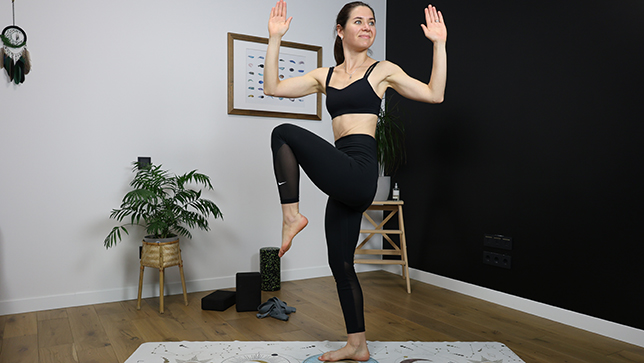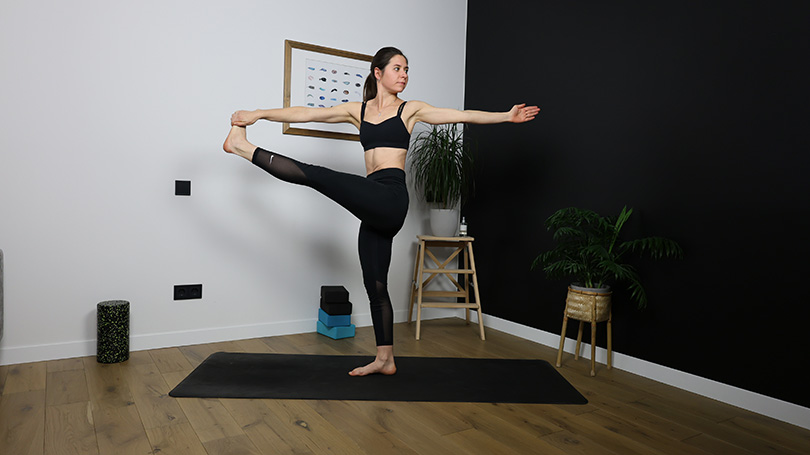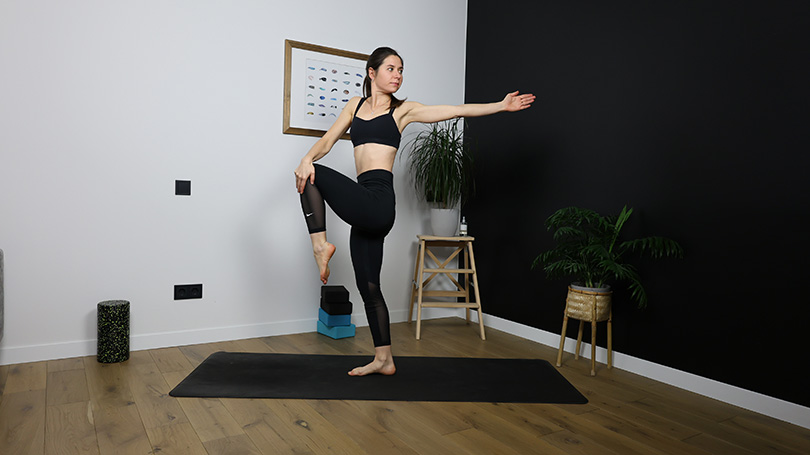Revolved Dancer Pose - Parivrtta Natarajasana

Contents
Revolved Dancer Pose or Parivrtta Natarajasana (PAR-EE-VRIT-TAH-NOT-AH-RAJ-AHS-ANNA) is a simple standing yoga pose that requires basic balance and flexibility in the lower back and hips. The name comes from the Sanskrit, parivrtta, meaning “revolved” or “twisted”; nata, meaning “dancer”; raja, meaning “king”; and asana, meaning “pose” or “posture.”
In this asana, the yogi stands on one leg and lifts the other with the knee bent. The arms are spread to the sides with bent elbows and palms facing forward, similar to a surrender sign. The torso twists toward the raised knee.
Parivrtta natarajasana is also known in English as Shiva Twist Pose.
Pose Detail
- By Type: Balancing Yoga Poses, Chest Opening Yoga Poses, Flexibility Yoga Poses, Hip Opening Yoga Poses, Shoulder Opening Yoga Poses
- Difficulty: Intermediate
- Body Position: Standing Yoga Poses, Twist Yoga Poses
Step-by-Step Instructions
Benefits and Contraindications
Helps in stretching the groin, abdomen, thighs, shoulders and chest
Opens the hips
Strengthening of the ankles and the legs.
Improving your overall balance
Increases leg and foot flexibility
Knee injuries
Spinal stenosis or spondylolisthesis
Herniated disc
High or low blood pressure
Menstruation and pregnancy
Modifications, Props and Tips
- If you have trouble balancing on one leg, you can modify the pose by placing the lifted foot against the calf or inner thigh of the standing leg. This will provide more stability and support for the standing leg.
- If you’re still having trouble with balance, you can practice this pose against a wall. Stand with your back against the wall and use it for support as you lift your leg and twist your torso.
- If you have mobility issues or are recovering from an injury, you can use a chair for support. Stand behind the chair and hold onto the backrest as you lift your leg and twist your torso.
- As with any yoga pose, it’s essential to focus on your breath. Inhale deeply as you lift your leg and exhale as you twist your torso. This will help you maintain your balance and stay focused.
Variation
Dancing Shiva Pose
The Dancing Shiva Pose represents an advanced level of yoga, offering a journey that is both challenging and empowering. In its complete form, the pose entails standing on one leg while extending the other parallel to the floor. With a firm grip on the big toe of the lifted leg using the opposite arm, you initiate a twist, turning to gaze behind you while simultaneously opening your outstretched arm.
This intricate combination of balance, flexibility, and strength contributes to the pose’s empowering and transformative nature.

If it is difficult for you to do Dancing Shiva Pose, you can try not to straighten your leg, but grab your knee with your right hand and stay in this pose.

Frequently Asked Questions
Parivrtta Natarajasana is an intermediate-level pose that requires balance and flexibility. It is not recommended for beginners, but modifications can be made to make the pose more accessible.
Avoid putting too much weight on your supporting knee or ankle, and avoid this pose if you have any knee or hip injuries. You should also avoid forcing the twist and instead allow your body to naturally twist.
Pregnant women should avoid practicing this pose as it involves twisting the abdomen, which can compress the uterus and potentially harm the developing fetus.
You can hold Parivrtta Natarajasana for about 30 seconds to one minute on each side. You can also repeat the pose multiple times during your yoga practice.